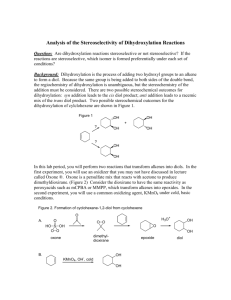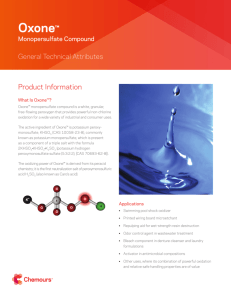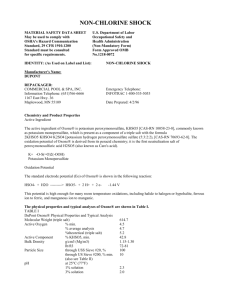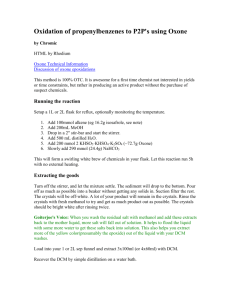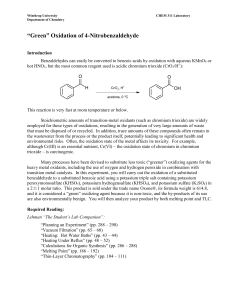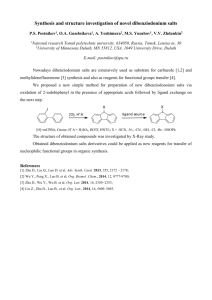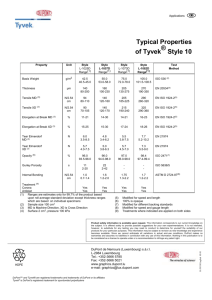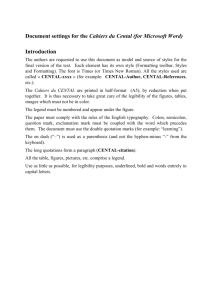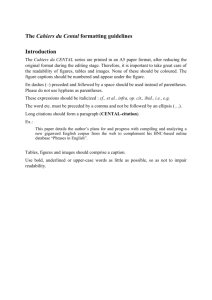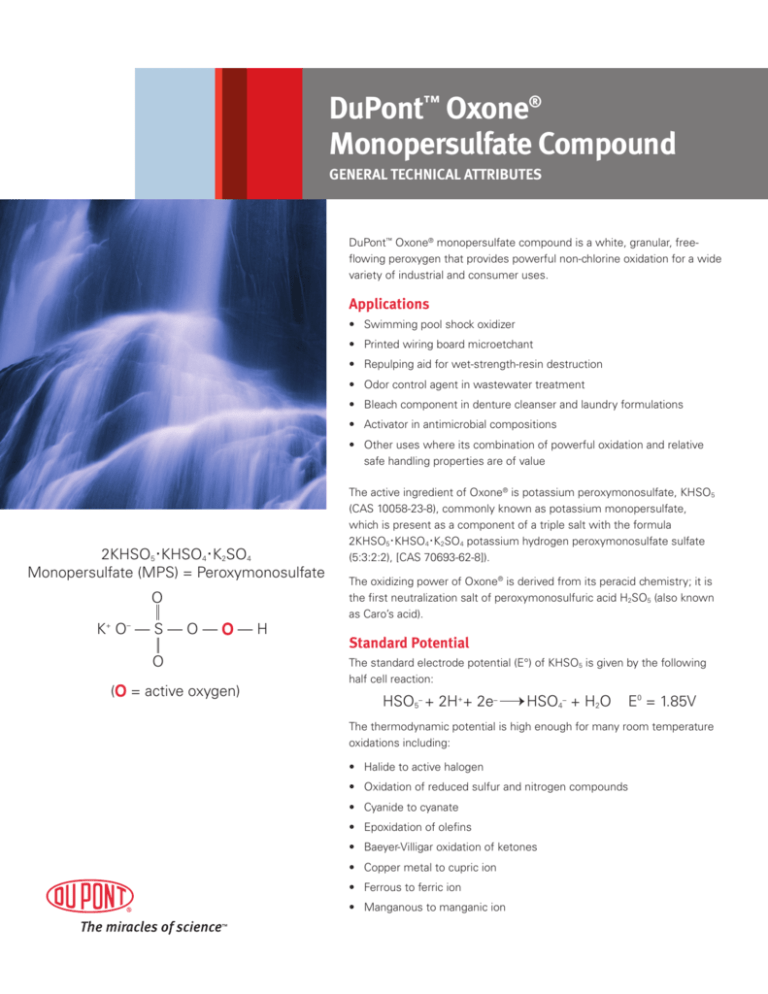
DuPont™ Oxone®
Monopersulfate Compound
GENERAL TECHNICAL ATTRIBUTES
DuPont™ Oxone® monopersulfate compound is a white, granular, freeflowing peroxygen that provides powerful non-chlorine oxidation for a wide
variety of industrial and consumer uses.
Applications
• Swimming pool shock oxidizer
• Printed wiring board microetchant
• Repulping aid for wet-strength-resin destruction
• Odor control agent in wastewater treatment
• Bleach component in denture cleanser and laundry formulations
• Activator in antimicrobial compositions
• Other uses where its combination of powerful oxidation and relative
safe handling properties are of value
2KHSO5·KHSO4·K2SO4
Monopersulfate (MPS) = Peroxymonosulfate
O
K+ O– — S — O — O — H
O
(O = active oxygen)
The active ingredient of Oxone® is potassium peroxymonosulfate, KHSO5
(CAS 10058-23-8), commonly known as potassium monopersulfate,
which is present as a component of a triple salt with the formula
2KHSO5·KHSO4·K2SO4 potassium hydrogen peroxymonosulfate sulfate
(5:3:2:2), [CAS 70693-62-8]).
The oxidizing power of Oxone® is derived from its peracid chemistry; it is
the first neutralization salt of peroxymonosulfuric acid H2SO5 (also known
as Caro’s acid).
Standard Potential
The standard electrode potential (E°) of KHSO5 is given by the following
half cell reaction:
HSO5– + 2H++ 2e–
HSO4– + H2O
E0 = 1.85V
The thermodynamic potential is high enough for many room temperature
oxidations including:
• Halide to active halogen
• Oxidation of reduced sulfur and nitrogen compounds
• Cyanide to cyanate
• Epoxidation of olefins
• Baeyer-Villigar oxidation of ketones
• Copper metal to cupric ion
• Ferrous to ferric ion
• Manganous to manganic ion
DuPont™ Oxone® Technical Attributes
Stability
DuPont™ Oxone® is a very stable peroxygen in the solid state
and loses less than 0.5% (relative) of its activity per month when
stored under recommended conditions. However, like all other
peroxygens, Oxone® undergoes very slow disproportionation
with the liberation of heat and oxygen gas. If a decomposition
is associated with high temperature, decomposition of the
constituent salts of Oxone® may generate sulfuric acid, sulfur
dioxide, or sulfur trioxide.
The stability is reduced by the presence of small amounts of
moisture, alkaline chemicals, chemicals that contain water of
hydration, transition metals in any form, and/or any material with
which Oxone® can react. Since the decomposition of Oxone®
is exothermic, the decomposition can self-accelerate if storage
conditions allow the product temperature to rise (see Product
Safety and Handling bulletin).
Aqueous solutions of Oxone® are relatively stable when made
up at the unmodified pH of the product (Figure 1). The stability
is adversely affected by higher pH, especially above pH 7. A
point of minimum stability exists at about pH 9, at which the
concentration of the mono-anion HSO5- is equal to that of the
=
di-anion SO5 (Figure 2). Cobalt, nickel, and manganese are
Figure 1. Effect of storage temperature on long-term stability
of acidic Oxone® solutions (120 g/L, pH 1.6).
particularly strong catalysts for the decomposition of Oxone® in
solution; the degree to which catalysis occurs is dependent on
the concentrations of Oxone® and of the metal ion.
Product Grades
Oxone® is available in both granular and liquid forms. By
screening, grinding, or compaction/granulation processing,
several granular grades (Regular, PS16, and CG) are produced
which differ in particle size distribution (Table 3). Liquid products
are specially-formulated to optimize active oxygen stability.
Please contact DuPont Sales and Support or an Oxone® technical
representative for more information and guidance about which
grade of product is best suited for your specific application.
Solubility
Oxone® is highly and readily soluble in water as shown in
Table 2. At 20°C (68°F), the solubility of Oxone® in water is
>250 g/L. At concentrations above saturation, potassium sulfate
will precipitate, but additional active component, potassium
peroxymonosulfate, will remain in solution.
Figure 2. Effect of pH on Oxone® solution stability
(3 wt% solution at 32°C)
25
100
Hours for 50% A O Decomposition
% Active Oxygen (A O) Remaining
110
21°C
90
80
70
35°C
60
50
40
30
40
60
Time, days
10
5
4.0
20
20
15
Hours
for 50% AO Decomposition
0
% Active Oxygen (AO) Remaining
0
20
80
100
5.0
6.0
7.0
8.0
9.0
pH
10.0
11.0
12.0
13.0
14.0
DuPont™ Oxone® Technical Attributes
Table 1
Oxone Physical Properties and Typical Analysis
®
Table 2
Aqueous Solubility of Oxone® Monopersulfate Compound
g/100 cc H2O
wt%
g/L
614.7
°C
°F
0
32
11.0
9.9
106
Min. %
4.5
5
41
15.1
13.1
144
Typical Analysis %
4.7
10
50
20.8
17.2
197
5.2
20
68
29.8
23.0
277
30
86
34.0
25.4
307
Molecular Weight (Triple Salt)
Active Oxygen
Theoretical % (Triple Salt)
Active Component KHSO5
Min. %
42.8
Typical %
44.7
Bulk Density
g/cm3 (kg/m3)
lb/ft3
72–87
% through U.S. Sieve #20
95
% through U.S. Sieve #200
4
pH, 25°C (77°F)
1% solution
2.3
3% solution
2.0
Solubility, g/100 cc H2O, 20°C (68°F)
29.8
Loss on Drying at 60°C, Max. %
0.1
Stability
Standard Electrode Potential (E°), V
104
42.0
29.6
357
122
43.6
30.4
375
60
140
46.0
31.5
387
1.15–1.40
Particle Size (PS16 Grade, see Table 3)
% Active oxygen loss/month
40
50
<0.5
+1.85
Heat of Decomposition
kJ/kg
251
Btu/lb
108
Thermal Conductivity
W/m·K
0.161
BTU·ft/h·ft2·F
0.093
Tables show typical properties based on historical production
performance. DuPont does not make any expressed or implied
warranty that this product will continue to have these typical
properties.
Table 3
Typical Bulk Density and Particle Size Analysis
of Oxone® Product Grades
Regular
PS 16
CG
Bulk Density
lb/ft3
72–79
75–87
56–75
g/cm3
1.15–1.27
1.20–1.40
0.90–1.20
U.S. Sieve, µm
–14 (1400)
>99
–16 (1180)
100
–20 (850)
95
–30 (600)
100
82
–70 (212)
—
—
–100 (150)
20
24
–200 (75)
5
4
–325 (45)
3
1
<1
DuPont™ Oxone® Technical Attributes
Analytical Test Methods
Loss on Drying
Active Oxygen/Active Component
1. Using the sampling procedure described above, weigh at least
two 10 ± 0.1 g specimens in tared, approximately 10.2 cm
(4 in) diameter, shallow aluminum weighing dishes.
1. Obtain a representative sample by riffling, quartering, blending,
or other means.
2. Carefully weigh (to at least three decimal places) at least two
specimens of 0.3 ± 0.05 g each.
3. Add to a 250 mL beaker or Erlenmeyer flask containing a
magnetic stir bar: 75 mL deionized water, 10 mL 20% (v/v)
sulfuric acid, and 10 mL 25% (w/w) potassium iodide solution.
(Deionized water and all reagents should be <20°C [≤68°F].)
Add a weighed specimen of Oxone®, and stir until dissolved.
4. Immediately titrate the specimen with 0.1 N sodium
thiosulfate solution to a pale yellow color. Add 2–3 mL starch
indicator solution, and the solution will turn deep blue.
Immediately continue the titration to a colorless endpoint that
persists for at least 30 seconds.
5. Calculations
% active oxygen = mLthio X Nthio X 0.008 X 100
% active component (KHSO5) = % active oxygen/0.1053
Specimen Weight (g)
6. Report the average of specimens analyzed.
2. Dry for 4 minutes in a Halogen Moisture Analyzer such as the
Mettler Toledo HG63 at 60 ± 0.5°C (140 ± 1.0°F).
3. At the completion of the drying program, the percent loss on
drying will be displayed.
4. Remove the specimen and cool to room temperature. Repeat
measurement on second specimen. Report the average of
specimens analyzed.
Other Testing Methods for Oxone®
Low concentrations of Oxone® (approx. 0–20 ppm), which are
commonly used in swimming pool treatments can be measured
in the presence of active chlorine by special test kits offered by
Taylor (Model K-1518 , Model K-1520) and Lamotte (Model 3360).
Taylor (Model K-1518) is a titrimetric test kit whereas Taylor
(Model K-1520) and Lamotte (Model 3360) are colorimetric.
In the absence of active chlorine, low concentrations of Oxone®
can be measured with a standard DPD-4 test kit; the result must
be multiplied by 5.0 to obtain the correct Oxone® concentration
in ppm.
In higher concentrations, Oxone® can be measured by addition
of a known quantity of ferrous ammonium sulfate (in excess),
followed by back-titration with standardized potassium
permanganate or ceric sulfate solution.
For further information, please visit our website at www.oxone.dupont.com
To speak with a Customer Service Representative, call
1-888-243-4608 North America, 302-892-7536 International
For medical emergencies call 1-800-441-3637 within the United States.
For those outside of the United States, call 302-774-1139
For transportation emergencies call 1-800-424-9300 within the United States.
For those outside of the United States, call 703-527-3887
Copyright © 2008 DuPont. All rights reserved. The DuPont Oval Logo, DuPont™, The miracles of science™, and Oxone® are registered trademarks
or trademarks of E.I. du Pont de Nemours and Company or its affiliates.
The information set forth herein is furnished free of charge and based on technical data that DuPont believes to be reliable. It is intended for use
by persons having technical skill, at their own risk. DuPont makes no warranties, expressed or implied, and assumes no liability in connection
with any use of this information. Nothing herein is to be taken as license of operation under or a recommendation to infringe any patents.
K-20102 (10/08) Printed in the U.S.A.

